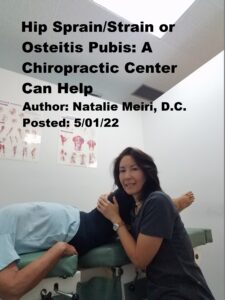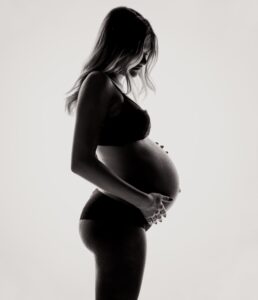
This post is about Hip Sprain/Strain or Osteitis Pubis: A Chiropractic Center Can Help. You may have had a fall onto the hip? Perhaps you have thigh pain from a sudden sports maneuver? Moreover, you may have developed this pain after a difficult delivery of a child or after a surgery? Certainly, as a weight bearing joint, the hip is commonly affected by degenerative joint changes and soft tissue damage. So your problem may be in the hip or pelvis, but can spread to other areas of the body, such as the upper thighs, groin and lower back. Similarly, you may just have a muscle strain in the thigh? Read on to learn more.
Hip Anatomy
The hip, like the shoulder, is considered a ball-and-socket joint. It is formed by the head of the femur (thigh bone) which sits in what’s called the acetabulum, a part of the pelvis. The head of the femur is large (ball) and the acetabulum (socket) is deep. The soft tissues (refers to non-bony structures that connect, support, or surround other structures) in your hip are:
- the muscles, which allow you to move.
- the tendons, which connect your muscles to the bone.
- the ligaments are bands of tough elastic tissue around your joints. They connect bone to bone, give your joints support, and limit their movement.
- the fascia – stretchy, thin, white fibrous tissue. All your muscles are enveloped in fascia.
- the bursae – fluid-filled pads that act as cushions at the joints. Bursae reduce friction between the surfaces of a bone and soft tissue.
-
Osteitis Pubis
Osteitis pubis is a painful condition of the pubic symphysis articulation/joint. Your pubic symphysis is a unique joint consisting of a fibrocartilaginous disc sandwiched between the articular surfaces of the pubic bones. The pubic bone is the most forward-facing bone of the pelvic bones.
Firstly, osteitis pubis is characterized by bony resorption (bone breaks down) and spontaneous reossification (new bone develops). Secondly, your symptoms may be localized or referred and is usually described as “groin burning”. Thirdly, the pain is often excruciating on direct palpation (touch) and relieved with rest. Fourthly, exercise or activities involving thigh adduction (bringing the thighs together), trunk flexion or even walking may cause pain. Fifthly, your gait may be antalgic (walk with a limp because of pain), with trunk flexion and waddling due to the pain. Lastly, an audible click in the area of the pubic symphysis may be heard during these activities.
Cause:
Although the mechanism or pathogenesis is uncertain, it can be due to the following:
– Pregnancy creates unique structural stresses to the female body. This coupled with ligament laxity resulting from maternal hormones may cause repetitive stress to the pubic symphysis.
– Surgery within close proximity to the pubic symphysis (e.g. prostate, bladder, urethra, uterus or cervix surgery). Signs and symptoms occur usually within one to three months after surgery. The frequency of this post-surgical complication is between 1 percent and 3 percent.
–Trauma/Injury involving a sudden, forced adduction (motion of bringing your thighs/legs inward) injury or a repetitive minor trauma seen with kicking or running.
-
Sprain or Strain
A sprain is a sudden or violent twisting injury of a joint with stretching or tearing of ligaments. A strain occurs when a muscle is overstretched or torn. This usually occurs as a result of fatigue, overuse, or improper use. Furthermore, damage to your attached tendons can also occur with a strain.
Adductor Sprain
These adductor group of muscles of the hip are located on your inner thighs. They are mostly used for bringing the thighs together (called adduction). This adductor muscle ligament injury may occur to an athlete who is involved in kicking, sprinting, water skiing, or jumping (high jumps or hurdles). A sudden pulling or contraction from a stretched position of hip abduction (movement of the leg away from thigh) or flexion (movement when knee comes toward the chest) can cause this injury.
Hamstring Strain
This group of hamstring muscles run along the back of your thigh from your hip to just below your knee. This injury may occur to an athlete or “weekend warrior” who feels a sudden pull or pop at the back of the thigh following a forceful knee extension (straightening your knee) maneuver. By over contracting the hamstrings while in a position of stretch, a tear may occur.
Quadriceps Strain
The quadriceps are a group of four muscles that make up the front of your thigh. This injury occurs with a sudden pulling pain in the front of the thigh after attempting to sprint,”missing” a kick, or suddenly stopping. So a sudden contraction of the quadriceps may result in a simple strain or a full rupture.

Treatment at Meiri Chiropractic for Hip Sprain/Strain or Osteitis Pubis: A Chiropractic Center Can Help
Treatment focuses on restoring normal mobility to the hip joint and pelvis. These treatments at Meiri Chiropractic include:
-Chiropractic manipulative therapy- to the hip joint, pelvis and associated regions.
-Gentle myofascial release and/or post isometric relaxation techniques- to the soft tissues (e.g. muscles, tendons, ligaments, fascia) involved.
-Electric Muscle Stimulation, Ice and Heat Therapies for pain relief and inflammation reduction.
-Therapeutic exercise- with gentle stretching and a long-term goal of restrengthening.
Finally, recommendations for prevention of further injury at the pelvis, hip and thigh. This involves a routine of stretching and warming up prior to activity.
Getting regular chiropractic care from a West Palm Beach chiropractic center can give relief naturally from an already existing injury, or even offer injury prevention. Chiropractic is a holistic and natural way to treat existing injuries and to keep your body in its best working condition.
Contact Meiri Chiropractic today at 561-253-8984 on Hip Sprain/Strain or Osteitis Pubis: A Chiropractic Center Can Help or/and other ailments.
References:
Thomas Bergman, David Peterson, Chiropractic Technique Principles and Procedures, 3rd edition, 2011
